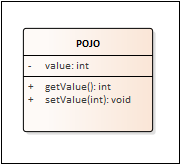In the beginning, no frameworks were available for the Java language. Developers mostly wrote their own classes. Along the way, many frameworks were introduced and many of them required classes to implement specific interfaces or extend framework classes in order to work with the framework. This coupled classes closely to specific frameworks; code could not be reused anymore unless the projects used the same frameworks. Not everyone was satisfied with this situation and soon a new trend became popular: return to Plain Old Java Objects (POJO). Many popular frameworks support POJO objects nowadays:

A class is considered a true POJO if: ...

